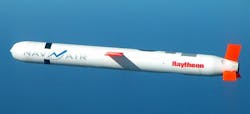Raytheon to replace obsolescent I/O circuit cards in Tomahawk missile communications system
PATUXENT RIVER NAS, Md., 1 April 2014. Cruise missile designers at the Raytheon Co. Missile Systems segment in Tucson, Ariz., will upgrade the satellite data link transceiver of the Tomahawk Block IV tactical land-attack missile under terms of an $8.9 million U.S. Navy contract modification announced Monday.
Officials of the Naval Air Systems Command at Patuxent River Naval Air Station, Md., are asking Raytheon to replace I/O circuit cards in the Tomahawk's satellite communications (SATCOM) system due to the obsolescence of the card's field-programmable gate array (FPGA), Navy officials say.
The contract also calls for Raytheon to test the new embedded computing cards to ensure that a satellite data link transceiver updated with the updated I/O circuit card meets all requirements. The satellite data link transceiver enables Navy controllers to communicate with the missiles while in flight.
The satellite data link of the Tomahawk Block IV long-range, all-weather, subsonic jet engine-powered cruise missile enables Navy controllers to alter the missile's speed in flight for targeting and fuel economy, as well as to retarget the missile after launch, if necessary.
The satellite link also enables the missile to transmit video imagery back to controllers immediately prior to impact to ensure the missile is heading for the right target, and the likely damage from the attack.
The Tomahawk Block IV is the latest variant of the Tomahawk cruise missile that has been in the U.S. military's inventory since the 1970s. The Block IV missiles are redesigned with an improved turbofan engine for deep-strike capabilities and are equipped with a real-time targeting system for striking fleeting targets.
The Block IV can be launched from Navy surface ships and submarines, and has a range of 900 nautical miles. The missile is designed to attack high-value land targets. Raytheon is developing new versions of the missile with bunker-buster capabilities and the ability to attack sea and moving land targets.
The Tomahawk Block IV missile launches from Vertical Launch Systems (VLS) aboard Navy surface warships, or from Capsule Launch Systems (CLS) from Navy submarines.
On Monday's contract to update the missile's satellite data link transceiver with new I/O cards, Raytheon will do the work in Tucson, Ariz. and Fort Wayne, Ind., and should be finished in July 2016.
For more information contact Raytheon Missile Systems online at www.raytheon.com, or Naval Air Systems Command at www.navair.navy.mil.

John Keller | Editor
John Keller is editor-in-chief of Military & Aerospace Electronics magazine, which provides extensive coverage and analysis of enabling electronic and optoelectronic technologies in military, space, and commercial aviation applications. A member of the Military & Aerospace Electronics staff since the magazine's founding in 1989, Mr. Keller took over as chief editor in 1995.

